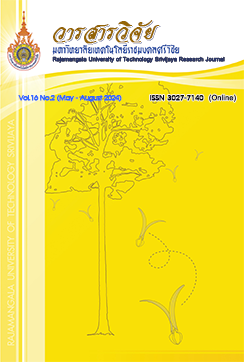Effect of Red Hawm Rice Seed Bio-Priming with Trichoderma harzianum on Seed Germination, Storability and Seedling Growth
Keywords:
seed bio-priming, Trichoderma harzianum, seed quality, seed storage, Red Jasmine RiceAbstract
Seed priming with Trichoderma harzianum can control plant pathology caused by fungi and promote seed germination and vigor. The primed seed must be used immediately as it rapidly deteriorates during storage. However, seed deterioration also depends on the storage temperature. Therefore, the effect of red jasmine rice seed priming with T. harzianum on seed quality and seedling growth rate during storage for 4 months was studied. The experimental design was 3x2 Factorial in Completely Randomized Design with 2 factors: Factor A representing seed priming (control, distilled water and T. harzianum) and Factor B representing storage condition (temperature 25°C and 10°C). Before and after storage for two months, the result showed that seed moisture content, germination, mean germination time shoot, and root length were not significantly different. After storage for 4 months, the result showed that the primed seed with distilled water and T. Harzianum, and stored at 10°C, had high seed germination (90.50% and 83.00%, respectively), and lower mean germination time (3.45 and 3.35 days, respectively) compared to other treatments. The primed seed with T. harzianum stored at 10°C had the longest shoot (10.19 cm) and root length (5.47 cm), with statistical significance. This study concluded that seed priming with T. harzianum promoted seed germination, average germination time and seedling growth rate. Storing primed seed at 25°C can preserve them for 2 months, while storage at 10°C can prolong preservation for 4 months.
References
Araújo, S.de.S., Paparella, S., Dondi, D., Bentivoglio, A., Carbonera, D. and Balestrazzi, A. 2016. Physical methods for seed invigoration: advantages and challenges in seed technology. Frontiers in Plant Science 7: 646.
Argerich, C.A., Bradford, K.J. and Tarquis, A.M. 1989. The effects of priming and ageing on resistance to deterioration of tomato seeds. Journal of Experimental Botany 40(214): 593-598.
Baki, A. and Anderson, J.D. 1973. Vigor determination in soybean seed by multiple criteria. Crop Science 13(6): 630-633.
Benítez, T., Rincón, A.M., Limón, M.C. and Codón, A.C. 2004. Biocontrol mechanisms of Trichoderma strains. International Microbiology 7(4): 249-60.
Buitink, J., Claessens, M.M.A.E.M., Hemminga, A.and Hoekstra, F.A. 1998. Influence of water content and temperature on molecular mobility and intracellular glasses in seeds and pollen. Plant Physiology 118: 531-541.
Chakraborti, S., Kuntal, B., Sanjoy, S. and Puspendu, D. 2022. Bio-priming of seed: Plant stress management and its underlying cellular, biochemical and molecular mechanisms. Plant Stress 3: 100052.
Chamnarnsin, P. and Ahromrit, A. 2011. Changes of Degree of Gelatinization, Gamma-Oryzanol Content and Antioxidant Activity of Coloured Rice after Heating, pp. 750-756. In The Graduate Research Conference 12th. Khon Kean University, Khon Kean. (in Thai)
Chamswarng, C. 2004. Biological control of vegetable diseases. Published documents, Faculty of Agricultural Technology, King Mongkut’s Institute of Technology Ladkrabang, Bangkok. (in Thai)
Division of Rice Product Development. 2022. Rice varieties and nutritional value, Red Howmm Rice. Available source: https://www. thairicedb. com/rice-detail.php?id=11, April 18, 2022. (in Thai)
Division of Rice Research and Development. 2016. Rice knowledge bank version 3.0. Available source: https://www.ricethailand. go.th/rkb3/title-index.php-file=content.php&id=90.htm, April 18, 2022. (in Thai)
Hlyka, I. and Robinson, A.d. 1954. Storage of cereal grains and their products, pp. 1-45. In Anderson, J.A. and A.W. Alcock, eds. American Association of Cereal Chemists. St. Paul, Minnesota.
Hussain, S., Zheng, M., Khan, F., Khaliq, A., Fahad, S., Peng, S., Huang, J., Cui, K. and Nie, L. 2015. Benefits of rice seed priming are offset permanently by prolonged storage and the storage conditions. Scientific reports 5: 8101.
ISTA. 2008. International Rules for Seed Testing. Seed Science and Technology. The International Seed Testing Association, Bassersdorf, Switzerland.
McDonald, M.B. 2000. Seed priming, pp. 287-326. In Black, M. and Bewley, J.D. eds. Seed Technology and Its Biology Basis. Sheffield Academic Press, Sheffield.
Murthy, U.M.N., Kumar, P.P. and Sun, W.Q. 2003. Mechanisms of seed aging under different storage conditions for Vigna radiata (L.) Wilczek: lipid peroxidation, sugar hydrolysis, Maillard reactions and their relationship to glass state transition. Journal of Experimental Botany 54: 1057-1067.
Nithya, N. and Geetha, R. 2017. Storability Evaluation of primed seeds of Rice (Oryza sativa) cv.PMK-4. Journal of Pharmacognosy and Phytochemistry SP1: 61-63.
R Core Team. 2011. R: A language and environment for statistical computing. R Foundation for Statistical Computing, Vienna, Austria.
Reddy, P.P. 2012. Bio-priming of seeds, pp. 83-90. In Recent advances in crop protection. Springer, New Delhi.
Roberts, E.H. and Ellis, R.H. 1989. Water and seed survival. Annals of Botany 63: 39-52.
Schwember, A.R. and Bradford, K.J. 2005. Drying rates following priming after temperature sensitivity of germination and longevity of lettuce seed. Hortscience 40: 778-781.
Sittigul, C., Srichuwong, S. and Tarungsri, S. 1992. Seed borne fungi of Basmati rice variety and treatments for their control. Journal of Agriculture 8(1): 31-40.
Swain, H., Adak, T., Mukherjee, A.K., Sarangi, S., Samal, P., Khandual, A., Jena, R., Bhattacharyya, P., Naik, S.K., Mehetre, S.T., Baite, M.S., Kumar, M.S. and Zaidi, N.W. 2021. Seed biopriming with Trichoderma stains isolated from tree bark improves plant growth, antioxidative defense system in rice and enhance straw degradation capacity. Frontiers in Microbiology 12: 633881.
Downloads
Published
How to Cite
Issue
Section
License
Copyright (c) 2024 Rajamangala University of Technology Srivijaya Research Journal

This work is licensed under a Creative Commons Attribution-NonCommercial-NoDerivatives 4.0 International License.
The content and information in the article published in Journal of Rajamangala University of Technology Srivijaya It is the opinion and responsibility of the author of the article. The editorial journals do not need to agree. Or share any responsibility.







